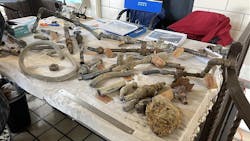Modernizing outreach strategies for lead service line replacements
Greater Cincinnati Water Works was experiencing low engagement rates with voluntary lead service line replacement programs. Initial attempts at line replacement utilizing a cost-sharing method yielded a 42% engagement rate.
When the utility switched to a fully funded model in 2021 that covered the whole cost of replacement for the customer, engagement only rose to 56% participation.
“We thought that would solve the issues, but in fact it did not – we only nudged it up slightly to the 56% signup rate,” said Kevin Osborne, division manager at Greater Cincinnati Water Works, during a presentation at the American Water Works Association’s (AWWAs) 2025 Annual Conference & Expo (ACE).
The utility serves roughly 1.1 million customers in southwest Ohio and Kentucky, and has about 33,000 lead service lines, two-thirds of which are on the customer side.
The utility has a strong inventory on its service lines, which should make things easier, but it suffered from low engagement rates for replacements – even with a fully-funded model.
This led Greater Cincinnati Water Works to develop an updated communication and outreach program with one goal – boost community engagement rates. The older model of outreach relied on traditional methods like mailed letters covered in text and cold calls. The program materials were wordy, intimidating and boring. The timing of the older model was also inconsistent and inadequate. When the customers saw that 100% of the costs for replacement were covered, they thought it was too good to be true. Combining that with an overall feeling of government distrust due to COVID made the low engagements no surprise.
The utility decided to switch its approach from overwhelming communication materials, inconsistent outreach and lack of trusted voices to a new, more modernized model. It shifted to a new approach that would understand customer barriers and design solutions to address them.
Greater Cincinnati Water Works refreshed its materials by using less text, engaging graphics and different outreach models. The utility developed a digital signing method that could be completed online or in person on a tablet. It also began a monthly Q&A series on YouTube and recorded customer testimonials to boost trusted community voices. Employees began sending text messages out for stronger outreach and improved accessibility.
The implemented changes significantly boosted participation rates from 56% to 89%.
Despite the success, the program still faces challenges with hard-to-reach property owners – the only ones who can sign off on the line replacements. Kevin Kappers, principal engineer at Greater Cincinnati Water Works, stated during an ACE presentation that this is likely due to the high percentage of renters in the area. Out-of-town landlords, ownership issues and those with outstanding utility bills are all less likely to respond.
The utility noticed that the new method isn’t a one-size-fits-all approach. Tailoring outreach to specific people proved beneficial. Younger residents may respond more to texts, while older residents may respond to phone calls.
“What we’re finding is that if we get ahold of someone, they’re going to sign it,” Kappers said.
About the Author
Alex Cossin
Associate Editor
Alex Cossin is the associate editor for Waterworld Magazine, Wastewater Digest and Stormwater Solutions, which compose the Endeavor Business Media Water Group. Cossin graduated from Kent State University in 2018 with a Bachelor of Science in Journalism. Cossin can be reached at [email protected].

